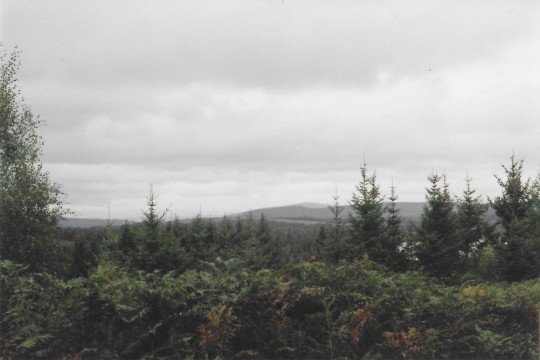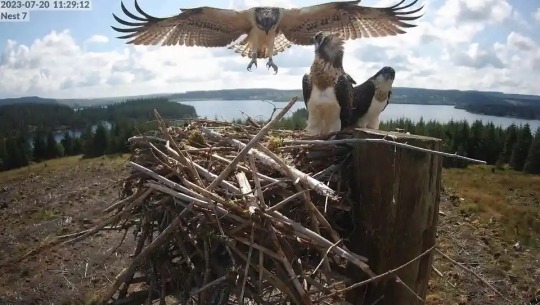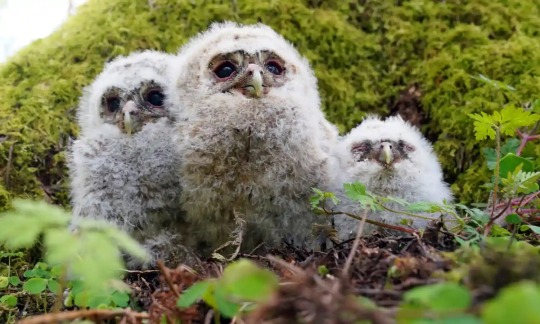#kielder forest
Text

northumberland 09/2023
#rural gothic#film is not dead#eerie#rural horror#camping#empty spaces#visual diary#on the road#unsettling#praktica mtl3#backroads#hiking#pine forest#northern england#northumberland#national park#kodak gold 200#kielder forest#rural exploration#35mm color film#pine trees#rural landscape#strange places#back roads#expired film#emptiness#liminality#vacant#kodak 35mm#overcast
38 notes
·
View notes
Text
Autumnwatch Hosts Unveil Stunning Wildlife Moments and Share Exclusive Behind-the-Scenes Stories from Their Latest Series Specials on The One Show.
Embracing the Wonders of British Wildlife with Autumnwatch Hosts
Chris Packham, Michaela Strachan, and Gillian Burke, beloved hosts of Autumnwatch, have taken us on an extraordinary journey through the captivating behaviors and seasonal changes of British wildlife. Their dedication to showcasing the natural world in all its glory is truly a gift to enthusiasts and curious minds across the United…

View On WordPress
#Autumnwatch hosts#Bird-watching#British wildlife#Chris Packham#Exe Reedbeds#Gillian Burke#Horseshoe bats#Kielder Forest#Michaela Strachan#Nature conservation#Nature series#Nocturnal animals#Red deer rut#RSPB Arne#Seasonal changes#Starling murmuration#The One Show#Tidal mud flats#Wildlife behavior#Wildlife enthusiasts
4 notes
·
View notes
Text

Kielder Forest, Northumberland, England
0 notes
Photo

#northumberland #kielder #nland250 #explorenorthumberland #nikond3400 #dslr #tamron70300 #exploring #hiking #forestryengland #forest #adventure #kielderwater #roadtrip #europe #traveller #travelphotography #hindhopelinn (at Kielder, Northumberland) https://www.instagram.com/p/CphuCvJo_xW/?igshid=NGJjMDIxMWI=
#northumberland#kielder#nland250#explorenorthumberland#nikond3400#dslr#tamron70300#exploring#hiking#forestryengland#forest#adventure#kielderwater#roadtrip#europe#traveller#travelphotography#hindhopelinn
2 notes
·
View notes
Text

Kielder forest & lake in Northumberland, United Kingdom
#canon#landscape#lakes#forest#photography#adobe lightroom#northumberland#nature#summer#original photographers#edit#my edit#editing#trees#trees and forests
160 notes
·
View notes
Text

Crafted by nature.
Kielder Forest, UK. A young osprey named Gilsland takes to the skies for the first time, watched by two of her siblings. The pair track her progress as she makes a 30-second circuit of the nest.
Photograph: Kielder Water/Forest Park/PA / Guardian #love #nature #wildlifephotography
1 note
·
View note
Note
What is one item on your bucket list?
Is this some kind of auto-generated bot question for new blogs? If not, apologies to the human who asked. I want to spend a night smack bang in the middle of Kielder Forest (UK) as far away from civilization as I can get.
0 notes
Text

northumberland 09/2023
#rural gothic#on the road#pine forest#film is not dead#eerie#rural horror#rural exploration#northern england#northumberland#praktica mtl3#kodak gold 200#visual diary#backroads#expired film#pine trees#camping#hiking#emptiness#unsettling#kielder forest#wasteland#35mm color film#back roads#rural decay#strange places#liminality#overcast#rural landscape#35mm film#vacant
13 notes
·
View notes
Link
Tawny owls have experienced a mini-baby boom in Kielder Forest, Northumberland.
0 notes
Text
Kielder Forest pine marten numbers rising, study suggests#Kielder #Forest #pine #marten #numbers #rising #study #suggests
One of the pine martens just 24 hours after the camera was installed in October
A study of pine martens, one of the UK’s rarest mammals, suggests they could be strengthening their presence in England’s biggest forest.
The elusive creatures were caught on camera in Kielder Forest, Northumberland, five years ago.
Sightings have increased since, and Forestry England began a project last February to…

View On WordPress
0 notes
Photo

Throwback 🏔️🏕️ #northumberland #kielder #nland250 #explorenorthumberland #nikond3400 #dslr #tamron70300 #exploring #hiking #forestryengland #forest #adventure #kielderwater #roadtrip #europe #traveller #travelphotography #hindhopelinn #trail #walking (at Hindhope Linn Waterfall) https://www.instagram.com/p/CpdrWswooHH/?igshid=NGJjMDIxMWI=
#northumberland#kielder#nland250#explorenorthumberland#nikond3400#dslr#tamron70300#exploring#hiking#forestryengland#forest#adventure#kielderwater#roadtrip#europe#traveller#travelphotography#hindhopelinn#trail#walking
2 notes
·
View notes
Text
Where can Eurasian Lynx be reintroduced in Scotland?
Eversince the reintroduction of wolves revived the Yellowstone National Park towards the end of the 21st Century, the reintroduction of predators have become common. However, one such reintroduction project has proven controversial and that is in the introduction of Eurasian Lnyx in the Scottish Highlands. Despite resistance from local ranchers, scientists are keen on reintroducing wolves to control the spurging ungulate population. Here we talk about a study which attempts to idnetify the most suitable location for lynx reintroduction in Scotland.
A Study of 3 Potential Sites for Reintroduction
A study attempted to understand the relative probability of population persistence across the three sites , which are Kintyre Peninsula, Kielder Forest and Aberdeenshire. Additionally, the impact of founding population size and multi sites reintroductions on the probability population persistence has been investigated.
The Methodology
Individual based modelling was used in this paper. This is in contrast to the Least Common Pathway used by previous studies (Hetherington et al., 2008). A prominent advantage is that IBM incorporates individual heterogeneity into the model (DeAngelis and Grimm, 2014). Each reintroduction was modelled for 100 replicates of 100 years after reintroduction. The mean number of occupied habitat patches, mean number of individuals and extinction probability over time were calculated at the 100 thyear.
For single site reintroductions, a founding population of 10 lynx were used across all sites. Meanwhile, a founding population size of 32 individuals were used for the multiple site reintroduction model. This model was based on the simultaneous reintroduction of 18 and 14 individuals at Kintyre and Aberdeenshire respectively. The model was then compared to the single site reintroduction models of both sites with founding population sizes of 32 each.
Kintyre Peninsular proved the best for the Reintroduction of Lynx
The probability of population persistence after 100 years was 83%, 35% and 21% of the replicates in Kintyre Peninsular, Aberdeenshire and Kielder Forest respectively. Furthermore, the mean number of patches occupied and the final population size after 100 years was the highest in Kintyre and lowest at Kielder.
The Kielder Forest has underperformed across all metrics. The model hence concludes that this site has an unacceptably low long term population persistence probability for lynx reintroduction. This has been supported by studies based on prey-based data analysis, which predicts that Kielder Forest can only support between 50–100 lynx (Hetherington and Gorman, 2007). This fall short of the minimum viable population criteria set by IUCN (Hetherington et al., 2008).
However, some studies suggest that the potential of the Kielder Forest as a reintroduction site might be underestimated. The site has less fragmentation and greater woodland cover (White et al., 2022)compared to Aberdeenshire. Additionally, in this model Kielder Forest was underrepresented. Thought it expands to England, the study was restricted to the Scottish region of the forest.
Across all three sites, there was a substantial increase in probability of population extinction between 10–30 years post release, which subsequently stabilized. Elevated extinction probability in all sites was probably associated with lower rates of patch colonisation following the saturation of the original reintroduction habitat. Figure 1 aptly depicts the lack of habitat connectivity amongst sites which demeans population viability.
A Lack of Habitat Connectivity a Potential threat to Reintroduction Success
From Figure 2, there is an evident low patch occupancy probability in the connecting habitat network after 100 years, regardless of release sight. This is consistent with a least common path analysis which predicts the low probability of a viable population being established in the landscape linking the proposed Highlands and Southern Upland sight (Hetherington et al., 2008). In figure 1, greater dispersion probability can be inferred when the lynx was reintroduced in the Kintyre Peninsula. This potentially explains why the region had significantly lower extinction probability relative to the other two reintroduction sites.
A lack of connectivity to other populations have threatened population persistence of reintroduced lynx in the Harz Mountains of Germany. This can be attributed to the lack of gene flow between metapopulations (Mueller et al., 2020).In fact, there has been significant inbreeding noted in the lynx population of the Dinaric Mountains, which is considered amongst the most successful for reintroduction projects (Sindičić et al., 2013).
Founding population size was predicted to have a substantial impact on the success of reintroductions. The single site reintroduction of 32 individuals in Kintyre, had a 10% greater population persistence after 100 years compared to that of a reintroduction consisting of 10 founding individuals. This is unsurprising as past studies of reintroductions in Central Europe have found that increase founding population size resulted in greater genetic diversity (Mueller et al., 2020).
Previous studies have considered Lynx reintroduction to be a success only if there was a probability persistence of 95% after 50 years (Kramer-Schadt et al., 2005). According to this benchmark, only a multi-site reintroduction with 32 lynx is the plausible option.
While politics and social issues are hindering the reintroduction of both lynx and wolves in the UK, more such studies are required before such drastic steps. A lack of potential habitat is threatening the success of India’s cheetah reintroduction project.
Help us Help Them! Think Wildlife Foundation is a non profit organization with various conservation initiatives. Our most prominent campaign is our Caring for Pari intiative. Pari is a rehabilitated elephant at the Wildlife SoS Hospital. 25% of the profits from our store are donated to the elephant hospital for Pari. Other than buying our wonderful merchandise, you could donate directly to our Caring For Pari fundraiser.
0 notes
Text
New study to boost elusive pine martens in England’s biggest forest | The Independent
0 notes
Text
Day 63
Sunday 3rd July 2022
A good morning. We woke up to not too much wind and considerably less midges than the west coast and top of Scotland had. We made ourselves toasties for breakfast. Well Benoît had toasties, and I had my marmite on toast with cheese which I find just as if not more delicious. Then we hit the road. We had a bit of a false start as we went to he Hermitage castle ruins but they were closed. Luckily it wasn’t too far out of our way so we headed back on our way towards Kielder forest and national park. It is a nice little area with well looked after routes laid out around the loch side. We did a quick walk around the area, checked out the sculptures that were there and enjoyed the views. We were tempted to buy a pizza at the pizza place there but resisted as we had already had a big breakie. But a nice place for a Sunday stroll. We then headed to Hadrian’s wall and fort. The wall spans for over 82 miles. And no surprise it was built by the romans. The furthest north the romans got to. The rest was unconquered. For any game of thrones fans out there this was one of the areas that inspired Martin for the “ice wall” in the north and he took a lot of inspiration from the battles and night watches of the Roman Empire. But hey not that I would know as it is too scary for me, but this is what Benoit tells me. It was a pretty impressive fort and even more so the wall was thick, long and straight. Very roman. We got to use our English VIP national trust cards to enter it. It was a bit fun to be visiting things again. We then headed to a pub for a cider and to recharge benoîts laptop so I could download some more books (I set myself a goal of 25 books this year and I think I am already at 20! And that included the whole series of Dune which is not the lightest of reads!) and so we can eventually get a bit more online. It was a nice afternoon. This evening we found an area to free camp again although we are back in England so it is slightly less legal… back to early mornings to pack up camp! We found a good spot. Heated up our left over polenta and then snuggled down for a movie. We watched the NZ classic that I had never seen, the piano. Love kate xxx
0 notes
Text
Association for Project Management Reveals the 50 Most Inspiring Projects From the Past 50 Years
LONDON–(BUSINESS WIRE)–The 50 most inspiring projects from the past 50 years have been announced by the Association for Project Management (APM), the chartered membership organisation for the project profession – in celebration of its 50th anniversary. Entitled ‘50 Projects for a Better Future’, the list features iconic projects from around the globe and across the fields of construction and engineering, technology, healthcare and education, sports and nature, arts and media.
More than 600 projects were nominated for inclusion in the list by a panel made up of APM members, APM branches, board members and industry experts. Projects were selected based on the transformative impact they have had on society, the economy and environment since their launch within the past 50 years.
The Channel Tunnel, the London 2012 Olympic and Paralympic Games, Guggenheim Bilbao Museum, Øresund Bridge, Wikipedia, the World Wide Web, the UK Covid-19 vaccine rollout, In vitro fertilisation (IVF), the Hubble Space Telescope, the Large Hadron Collider and Mars Perseverance Rover all make it onto the list. The full list including project details is available now at apm.org.uk/50projects
Professor Adam Boddison, Chief Executive of APM, says: “To mark our 50th anniversary we wanted to celebrate and recognise the impact that projects have had on the world, and the important role that project professionals play in embracing change and opportunity. The 50 projects on this list all have their own legacy in the impact they have had on society, the economy and environment, as well as acting as a catalyst for other projects which followed and will follow them in the future.”
Construction and Engineering Projects:
Hong Kong International Airport (1998)
The Channel Tunnel (1994)
The Øresund Bridge – (Sweden/Denmark) (2000)
Canary Wharf – London (1991)
The Thames Barrier – London (1984)
The Falkirk Wheel – Scotland (2002)
Maeslant Barrier (Netherlands) (1997)
Unisphere (United States) (2018)
Madrid Metro Extension (1995-2003)
The Peace Bridge (Northern Ireland) (2011)
Sports, Media and Arts Projects:
FIFA Women’s World Cup (2019)
London Olympic and Paralympic Games (2012)
Parkrun (2004)
Forest Green Rovers (2010)
Angel of the North (1998)
BBC Children in Need (1980)
Guggenheim Bilbao Museum (1997)
Hamiliton (2015)
Tate Modern (1994)
Healthcare and Education:
HIV antiretroviral therapy (Mid 1990s)
EPS Electronic Prescribing Service (2013)
Global Polio Eradication (1988)
HPV Vaccination (2008)
Human Genome Project (1990-2003)
In Vitro Fertilisation (IVF) (1978)
Tackling Poverty in Renfrewshire Programme (2014)
UK Covid-19 vaccine development and roll out (2020)
Educating girls in the Swat Valley (2013)
Netherlands cycling revolution (1970s)
Nepal earthquake response (2015)
Science and Nature Projects:
International Space Station (1998)
Howdon and Bran Sands Gas to Grid plants (2012)
Hubble Space Telescope (1990)
Kielder Reservoir (1982)
Large Hadron Collider (2008)
The Mars Perseverance Rover (2020)
Svalbard Global Seed Vault (2008)
The Eden Project (2001)
Cloning of Dolly the Sheep (1996)
The Voyager spacecraft programme (1977)
Technology Projects:
Amager Bakke – (2017)
Global Positioning System (GPS) – (1973)
The PACUNAM Lidar Initiative (discovery of Mayan cities) – 2016
Landsat (1972)
Raising the Mary Rose – (1982)
The Train Protection and Warning System (TPWS) – 2003
The Eurofighter Typhoon – (1983)
Wikipedia – (2001)
World Wide Web (1989)
SWIFT banking service (1977)
Visit APM’s ’50 Projects for a Better Future’ for details.
https://ift.tt/1AGVEjb
https://ift.tt/zUhQTfO
#Saas#softwaresystems#productdevelopment#software#practice#optimization#accuracy#efficiency#productivity#softwareprojects#cracksthecode
0 notes
Text

Tawny owl chicks in Kielder forest, UK. Wildlife experts have reported a mini-baby boom among tawny owls. An increase in the number of voles, their most important prey, has led around 90 tawny pairs to have chicks, compared with just 25 in the area last year. Photograph: Owen Humphreys/PA #tawnyowl #recovery #kielder
0 notes